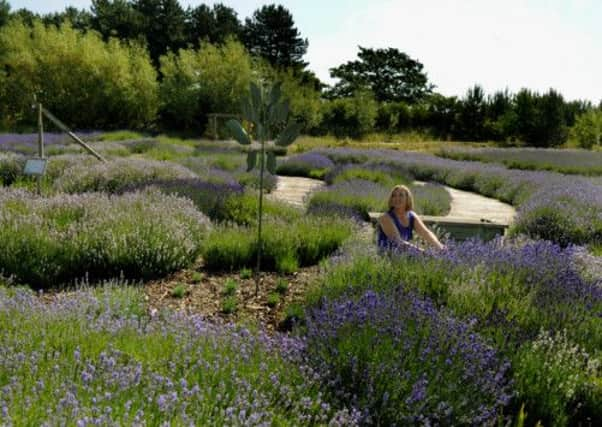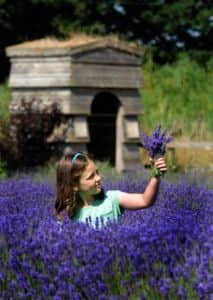A purple haze and liquid gold


It was a £2.50 soil testing kit from B&Q which sealed the deal.
Ten years ago, standing on 12 acres of redundant scrub land half a mile from the A64 near Winteringham, Steve Jaques was the first to admit that his plan for a thriving rural business required a certain amount of vision. The soil was so poor it was impossible to cultivate traditional crops like wheat and barley and, while in a former life it had been a piggery, after the last owners had moved out in the 1950s it had gradually become a dumping ground for other people’s rubbish.
Advertisement
Hide AdAdvertisement
Hide Ad“It was probably one of the worst strips of land in Yorkshire, but at the time I was looking for a challenge,” says Steve, then director of the Second World War museum Eden Camp. “I’d been at the museum since its very early days and I felt I’d taken it as far as I could. We’d achieved everything we set out to do and after 15 years the time seemed right to move on. I had no idea what I wanted to do, but I liked the idea of working for myself. On the way to the museum each day I would drive past this bit of land and when I noticed a For Sale sign had gone up I couldn’t resist having a look.”


A quick survey of the site confirmed what successive generations of farmers already knew – below the six to 12ins of sandy topsoil lay 28ft of pure yellow golden sand. It would have been enough to send even the most experienced arable farmers packing, but Steve and wife Anne already had the seeds of a plan.
“There are only two things that can grow on soil like this – carrots or lavender. We reckoned we might struggle to support the two of us selling carrots, but at the time Anne was training in garden design and we reckoned if we could open a lavender farm which would operate both as a manufacturing business and a tourist attraction it might just work. The key was the soil. If lavender is to flourish then it needs to be neutral to alkali, and that bit of kit costing just a few pounds told us it was. From there we never looked back.”
Native to the Mediterranean, lavender is used to dry and rocky conditions and the couple planted their first crop in the Christmas of 2002. They thought they might have to wait 18 months before opening to the public, but by the following June the lavender was already blossoming and as Wolds Way Lavender welcomed its first visitors, Steve, whose background is in engineering, was hard at work designing his own distillery to harness the plant’s oil.
Advertisement
Hide AdAdvertisement
Hide Ad“I went to visit various farms across the country and I have to say everyone was incredibly kind and really happy to share their knowledge, particularly Norfolk Lavender, which was founded back in 1932 and has 100 acres under cultivation.
“Ours was going to be a farm on a much smaller scale, but Anne and I were basically complete novices and just to have people there to talk you through the likely pitfalls made a big difference.”
Taking the best ideas from each of the farms and adapting them for the needs of their own venture, Steve built the country’s only wood-fired lavender distillery and, in 2005 the couple were able to bottle the first drops of oil, known for good reason as “liquid gold”. It takes 300 stems of lavender to make just ½ litre of oil and in total the business only produces between 10 and 15 litres each year. It might not seem much for the amount of man-hours which go into running the farm, but so potent is the oil that just the smallest drop is enough to add scent to the farm’s range of shampoos, body lotions and soaps.
“The process we use is very traditional and it was important to us to preserve the heritage of lavender farming,” says Steve. “We generally start harvesting in July and the distillation process takes place throughout August and it has become something of a spectator sport. Once complete you are left with oil on top of the floral water which is then filtered off. The distillation process agitates the oil so it then needs to be left for six to 12 months. It’s a slow process, but then this was never some get rich quick scheme.”
Advertisement
Hide AdAdvertisement
Hide AdWhile other farms were hit hard by last summer’s heavy downpours and the freezing temperatures of March which made it the coldest on record, lavender has proved to be pretty resilient to even the worst the British climate can throw at it.
“Obviously bad weather affects our visitor numbers,” says Steve. “But the plants pretty much carry on regardless.
“We did have quite a slow start to the year, but nature has as a way of catching up and the recent heatwave really helped this year’s crop get back on track. While most flowering plants require constant nurturing and attention, lavender is happiest when it’s left alone.
“We have a lot of people who tell us their plants have died and wonder what our secret is, but the truth is most people kill lavender with kindness, either by over-watering or over-feeding and often both. Really all the lavender asks for is a yearly hair cut after flowering.”
Advertisement
Hide AdAdvertisement
Hide AdWolds Way Lavender now boasts 120 varieties of lavender, wild flowers and herbs and Steve and Anne are about to launch a new range of products. It’s partly to mark 10 years in business, but also a recognition of the increased demand for natural remedies.
The use of lavender is nothing new and dates back to the time of the ancient Greeks who used lavender as part of their religious ceremonies. During Roman times, the flower was was sold for 100 denarri per pound which was the equivalent of a farm labourer’s monthly wage. It was the Romans who introduced the plant to Britain – the name deriving from the Latin “lavare” – meaning to wash.
They saw the herb as a cleansing product as well as being their own natural first aid kit and the scent soon became a firm favourite among the nobility, leading to the growth of lavender in many stately homes across the country. Over the centuries it has been used to aid sleep, soothe headaches, the pain of sunburn and insect bites and as a flavouring in cooking.
While along with lily of the valley, lavender became a favourite perfume for women of a certain age, Steve says its rather old-fashioned reputation has been dispelled over recent years and the plant is enjoying something of a renaissance.
Advertisement
Hide AdAdvertisement
Hide Ad“It’s the same with food, there is a real demand for cosmetics and toiletries which are made with natural ingredients. People can visit the farm and know that the products they are buying are made with lavender grown just a few feet away.
“Like a lot of herbs and flowers we are really rediscovering their uses and while I don’t want to say too much at the moment we have some really exciting plans for the future.”
The plantation at Wolds Way Lavender covers five acres and while the Jaques enterprise is never going to compete with countries like Bulgaria and France where lavender is farmed on an industrial scale, the last decade has proved to them that there is a market for the home grown plant.
The couple’s cosmetics range is manufactured by a company in Thirsk, their dried lavender is used by Bettys Tearooms in their scones and the farm, which boasts a giant beehive, also runs a successful honey business. Everything is geared towards the practical – even the miniature gauge railway as well as being an attraction for younger visitors is also used to transport the plant stems to the distillery.
Advertisement
Hide AdAdvertisement
Hide Ad“I guess coming from Eden Camp I wanted to make the farm educational as well as a fun place for families to visit,” says Steve. Having turned the piggery buildings into a comfortable home, the Jacques now live on site and admit the farm is much more than a business, it’s a way of life.
“We open to the public between Easter and October, but the work goes on right throughout the year,” says Steve. “All the lavender plots have to be hand weeded and just maintaining the grounds and the various facilities is a full-time job.
“In many ways the last 10 years have flown by. One of the first things we did was plant 7,000 trees around the site and replace the hedging. They’re now 25ft high and it’s only when I look at them I realise how far we have come. It has honestly been the hardest 10 years of our life, but I wouldn’t swap the life we have now for anything.
“Any time I doubt what we are doing I look at the photographs we took of the site when we bought it. There is a real sense of satisfaction about building something like this from scratch. People also tell me the aroma is lovely, but we’ve both been exposed to lavender so much, neither of us can smell a thing.”
• For more information about Wolds Way Lavender visit www.woldswaylavender.com